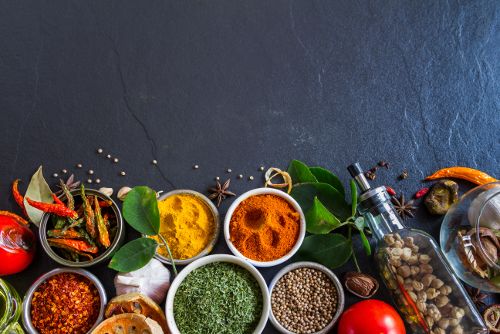Natural, Clean Flavors Still Meet Consumers’ Taste for Indulgence at IFT 2017
From up-and-coming flavor trends like spicy gochujang to new applications for guilt-free, indulgent flavors, companies like Synergy Flavors, Gold Coast Ingredients, and Innova Market Insights discussed growing trends and innovative applications.
Photo © Shutterstock.com/joker1991

Flavor is, of course, a critical element of food and beverage formulations, and this year at the Institute of Food Technologists (IFT) Annual Meeting & Food Expo 2017, flavor took center stage. From up-and-coming flavor trends like spicy gochujang to new applications for guilt-free, indulgent flavors, companies like Synergy Flavors (Wauconda, IL), Gold Coast Ingredients (Commerce, CA), and Innova Market Insights discussed growing trends and innovative applications.
A common theme at this year’s show was how marketers can still meet ongoing consumer demand for clean, natural ingredients in food and beverages without forcing consumers to sacrifice taste for health, and vice versa. Synergy Flavors is tapping into this trend with its #CleanEating, #CheatDay campaign, which, according to Parveen Werner, associate marketing director at Synergy, captures consumers’ desire to eat healthy most of the week, but to indulge-or have a cheat day-on occasion. The company believes that its “dual personality” flavor offerings embody this paradox. Some of the indulgent-flavor applications the company showcased included a gin and tonic float featuring natural lime extract and juniper essence, s’mores brownie bites with natural marshmallow, and three different flavors of cookie dough truffles, including an Instagram-worthy, unicorn-colored variety.
The key to achieving this balance of function and flavor, said Lindsey Oostema, senior marketing specialist at Synergy, is that the flavors used in these applications are all-natural (hence the emphasis on clean eating) but still have the decadent taste most often associated with foods that are less than healthy. “You can have fun and still be on the natural spectrum,” she told Nutritional Outlook at the show.
Plant-based protein-both for general consumers and for athletes-is another all-natural trend that continues to gain steam. Oostema also said that, while indulgent flavors have long been a staple in whey-based products, the demand for plant and pea protein is leading manufacturers to get a little more creative when flavoring plant-based protein products-particularly for sports nutrition. “Chocolate, vanilla, and strawberry are the top flavors for sports nutrition no matter whether it’s plant-based or whey-based,” she said. “But there are some obstacles to overcome with plant-based [products], so making those indulgent profiles come through is a little more difficult.” According to Oostema, it’s all about finding the flavor profiles that go best with a pea or plant protein. With pea protein, for example, taste can be an issue. Using traditional flavors like dark chocolate or fudge might not work as well, but a flavor like bananas foster does, she said.
Megan Trent, marketing, Gold Coast, echoed this sentiment: “Protein is definitely [about] indulgent flavors. You’re still going to see your cookies and cream, [but maybe also] a new dessert-whether it’s a crème brulee or a horchata. People experiment a little bit.”
In general, many companies emphasized consumers’ desire to get back to the basics-whether by using all-natural flavors or ingredients, as evidenced by the increasing popularity of #CleanEating, or by incorporating allergen-free and vegetarian ingredients. Trent told Nutritional Outlook that a major trend in 2017 is the return to simple flavors-“anything from honey to maple to new, fresh fruits and vegetables.” Plant-based and vegan/vegetarian-friendly options were also a key focus. At this year’s show, Gold Coast showcased its dairy-free cheese line and savory vegetarian options. Of particular note, Trent said, are the company’s vegetarian shawarma and lamb flavors. “There are so many new meat substitutes out there, so we’ve really been growing…and we think it’s trending.”
Spicy Is In
Gold Coast also turned its attention to savory and spicy flavors. In recent years, said Trent, savory flavor trends have been dominated by Asian-inspired flavors like Korean BBQ. While those flavors remain popular, there’s a new spicy flavor that some in the industry are predicting will be the “new Sriracha,” she said. Gochujang, which originates in Korea, is a red chili paste said to be spicy, sweet, and savory all at once. In addition to Gold Coast’s shawarma and lamb flavors, Trent said, the company highlighted its gochujang flavor at the show as well.
Innova Market Insights’ IFT presentation also featured gochujang. Joanna Clifton, market analyst at Innova, told Nutritional Outlook that product launches with a hot or spicy description claims increased by 22% from 2012-2016. In addition, she said, 32% of Americans say that they enjoy spicy flavors in beverages, according to the company’s consumer survey. Regarding gochujang, Clifton said: “It’s becoming huge. You can see it growing already, obviously with fewer launches than Sriracha, but [it] could possibly be the next Sriracha.”
Overall, flavor companies said their goal is to answer consumers’ call for cleaner ingredients while offering bolder flavors and innovative flavor applications. As Trent noted: “I think people are always looking for what’s next...they want to push what’s new.”
Also read:
2017 Flavor Trends for Food and Beverage
Which Flavors Are Trending in Energy Drinks?
Which Flavors Work Best for Dairy Protein versus Plant Protein?
Prinova acquires Aplinova to further increase its footprint in Latin America
April 7th 2025Prinova has recently announced the acquisition of Brazilian ingredients distributor Aplinova, which is a provider of specialty ingredients for a range of market segments that include food, beverage, supplements, and personal care.










